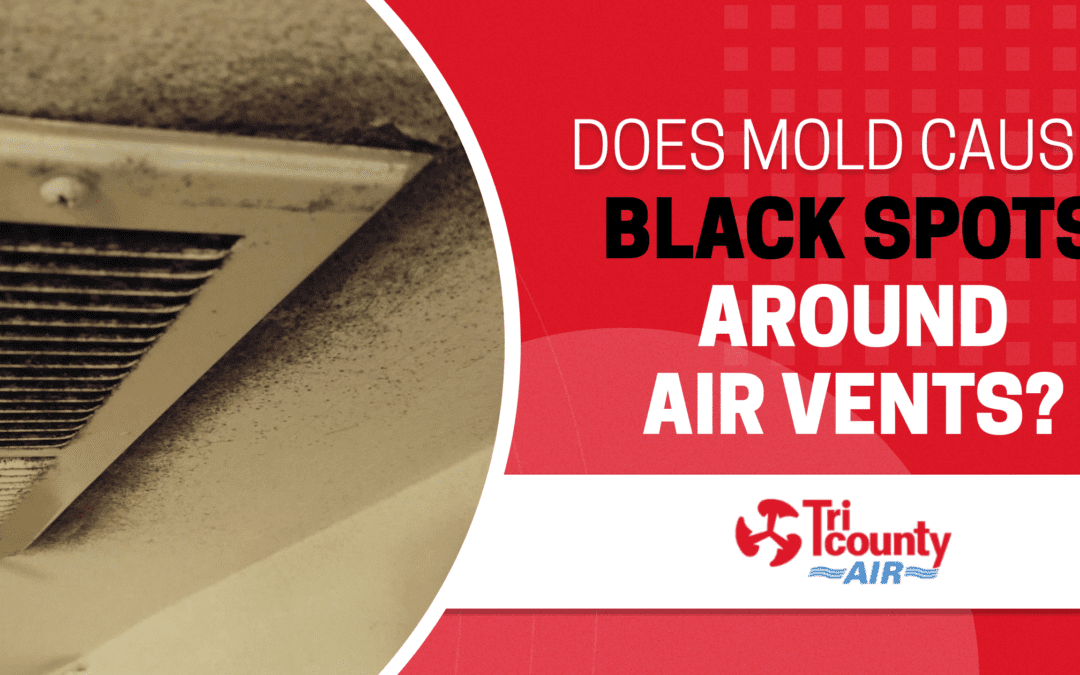Black spots around air vents in your home can be a sign of black mold. If you’ve eliminated potential causes, such as fireplace soot or a leaky duct, address the problem immediately. Black mold can be highly toxic. And, the longer you wait, the more difficult and expensive it will be to remove.
Where Does Mold Come From?
Mold spores are ever-present in the air. They tend to settle in damp, dark places where they grow into larger patches. The inside of an air conditioning system is often an ideal environment for mold growth. If there’s mold in your AC system, spores can be carried with the airflow and grow near vents.
How Do I Know Black Spots Around Air Vents Are Mold?
You can suspect that mold is present if the discoloration is concurrent with a few other signs, such as:
Musty Odors
This strong odor is hard to miss. It’s likely caused by mold if cleaning or airing out your home doesn’t help. At first, you may only smell it near a particular vent or part of your home. If the mold spreads, you’ll start to notice the odor everywhere.
Black Dust Around Vents
Inspect vents closely for black dust at least twice a year and after a flood or plumbing incident. Its presence can be subtle. If the vents are dusty when air is moving, mold spores may be present. Persistent black specks around vents mean mold is starting to grow and spread.
Worsening Allergies
Black mold can trigger allergy-like symptoms. If you’re experiencing these symptoms outside of allergy season, that’s a reason to be suspicious. Signs to look for include coughing, sneezing, or itchy, watery eyes. Difficulty breathing is also a sign of mold exposure. You may experience itchy skin as well.
Frequent Headaches
Headaches caused by black mold can occur daily. They may go away when you leave your house and recur when you return home. Mold-induced headaches are often minor at first. But they can get worse and turn into migraines over time.
Lack of Energy
Other symptoms of black mold include a lack of physical and mental energy. If you experience unexplained fatigue, check around AC vents for signs of mold. Brain fog is also associated with black mold. It can interfere with awareness of what’s happening, so be diligent and check for mold if there’s no explanation for your lack of clarity.
How to Confirm Black Spots Around Air Vents Are Mold
Testing kits are available. However, DIY methods aren’t as reliable as professional testing services. If you test for mold yourself, a minor mistake can cause a negative result even if the sample is mold.
You can also inspect the vent with a flashlight to look for dark patches and other visible signs of mold. While this can help identify a problem, it can be hazardous. Exposure to black mold can make you sick. The best and safest option is to hire a professional to test for mold, fungus, or other contaminants and determine how to resolve the issue.
Schedule Professional Mold Removal
Professionals wear protective gear to safely work near mold. They use tools and equipment that effectively remove all traces of it and prevent future growth. A technician can also identify whether mold has spread beyond the vents and ducts. If necessary, they can clean your entire HVAC system and other affected areas. The sooner you call, the quicker the problem can be resolved.
Call Tri County Air
We can provide whole-home high-MERV filtration, whole-home HEPA filtration, UV light purification, and other indoor air quality solutions. Serving Charlotte, Manatee, and Sarasota Counties, we know how easily mold can grow in Florida. Our trained technicians can evaluate your home and determine the best solutions to prevent mold spores, odors, bacteria, viruses, dust, and more from circulating indoors. Request an appointment online or call (941) 485-2222 to get started.

